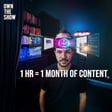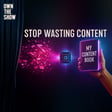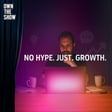Become a Creator today!Start creating today - Share your story with the world!
Start for free
00:00:00
00:00:01

The First Real Look at AI-as-UI in Marketing (And It’s Wild)
In this AI marketing podcast episode, Dan Sanchez sits down with Jason Telmos, VP of Product Marketing at 6sense, to break down the game-changing AI capabilities coming to the 6sense platform. Fresh off the Breakthrough conference in Las Vegas, Dan shares insights into how 6sense is not just layering AI onto its existing product—it's redefining how users interface with data and act on it. From intent data and predictive scoring to autonomous workflows and AI agents, this episode unveils what could be a category-defining evolution in B2B marketing tech.
My Favorite AI Tools
- Tella - https://danchez.com/tella
- High Level - https://danchez.com/highlevel
- Zencastr - https://danchez.com/podtools
- n8n - https://danchez.com/n8n
Resources Mentioned
- 6sense - https://6sense.com
Timestamps
- 00:00 - Sixth Sense at Breakthrough: Dan's first impressions
- 03:15 - Jason's path from ABM rookie to 6sense exec
- 08:40 - 6sense's origin story & core value in intent data
- 15:00 - AI as the new UI: Sixth Sense's vision shift
- 20:30 - Why segmentation is still king in ABM
- 26:55 - AI email agent & automated personalization
- 33:40 - Workflows: from manual segmentation to triggered automations
- 41:10 - Revy AI: chat interface meets B2B data orchestration
- 50:00 - Where marketing is heading in the next 3-5 years
Transcript
Introduction and Insights from Sixth Sense Conference
00:00:00
Speaker
Welcome back to the AI Driver Marketer. I'm Dan Sanchez. My friends call me Danchez. And I had the privilege of doing an interview with Jason Telmos, who is the VP of Product Marketing over at Sixth Sense.
00:00:11
Speaker
actually just got back from their conference called Breakthrough over in Las Vegas just a few days ago. And I wanted to let you guys in on what they were actually doing with AI in their product. They had an amazing lineup of some AI tools that are coming to Sixth Sense. And I think it's a big deal. It's almost an industry-defining moment.
AI's Impact on SaaS and User Interfaces
00:00:29
Speaker
Because they're leading the pack on what I think is going to become a standard play for a lot of big SaaS companies. Not just using AI as a feature of the product, but using AI that becomes almost the new UI for how you get value out of that product.
00:00:46
Speaker
So I break down a number of different things that I think are very exciting for Sixth Sense, but I want you to pay special attention to how they're incorporating AI and what that means for your
Sixth Sense's Potential and Innovations
00:00:57
Speaker
workflows, your tools.
00:00:58
Speaker
And of course, if you're like mid-market to enterprise, this tool, Sixth Sense, you found out from yesterday's episode, but this is going to be a game changer for you. This is a fantastic tool in order to get insight into what your buyers are doing, to get insight into which buyers are actually beginning to enter the market for what it is you sell.
00:01:19
Speaker
I've become a fan of Sixth Sense after going through the conference, and I am drinking a little bit of the Kool-Aid here for good reason. I've seen a lot of AI tools. I'm very excited for the direction they're going as a company, and I will be cheering for them now.
00:01:30
Speaker
on the sideline from my
Jason Telmos's Marketing Journey and Sixth Sense Involvement
00:01:31
Speaker
podcast. So without further ado, here is the interview with Jason. know stage and you were giving us the big updates about Sixth Sense.
00:01:45
Speaker
all I love the energy you were putting out too, because you're not just a VP of product or product marketing, you're past customer Sixth Sense. You've been in the game. yeah You've actually been doing it. So you know the pain, you know the trial, yeah you understand the audience. ye And I think that, I don't know, that I could feel it as you were talking about it. You were excited about these new updates. yeah But I'd love it if you could go back a little bit yeah to what it was like to be a customer, but even farther back. Like for those people who have never heard of Sixth Sense, kind of give me the original vision, yeah how you got involved and how you got to where you are now. Yeah, and I remember being in that exact
Understanding Account-Based Marketing with Sixth Sense
00:02:21
Speaker
spot. i you know I didn't tell the story on stage, but I started my career in marketing, but really in consulting. So I worked for a smaller boutique go-to-market firm, and it was basically my very first project that I had ever been on. Before that, I was basically cleaning up PowerPoints.
00:02:37
Speaker
But my first at bat, they're like, all right, Telmos, you're in, get in here. And I went into a company and was sitting in the room with, you know, our sales guy on the consulting side and the CMO of the company that we were working with, a couple of their execs.
00:02:50
Speaker
yeah And they're all talking about these things. And they're primarily sales guys, right? So they're telling them about like, oh, we're going to drive growth and revenue and we're go to do ABM. And everyone's like nodding their heads. And I'm like, yeah, yeah, great. They're like all right, Telmos, you're going to, you know, deliver this project. go Go do an ABM. I'm like, right, awesome.
00:03:05
Speaker
Cool. So I go back to my hotel room and I'm like, but is it what is ABM? And I'm like trying to figure it out. And I was talking to a buddy of mine because I just couldn't... I'm like, well, this is B2B, right? Like, isn't everything account-based marketing and B2B? Like, you're you're not selling to a consumer. So it took me a minute to ride around.
00:03:22
Speaker
And it's actually how I i found out about Success. it was my first...
Importance of Signals, Scores, and Data in Marketing
00:03:25
Speaker
really foray into kind of this MarTech world, because I Googled it, right? and of course, one of the first things that came up at the time was Sixth Sense. And so I did a bunch of reading, a bunch of learning. And you know basically since then, the way that I came to realize what ABM is and and kind of wrap my own head around it was was pretty simple, right? Like we're selling to accounts, but really what Sixth Sense is and what ABM vendors and kind of the space has always been is we need two things.
00:03:52
Speaker
We need signals, right? We need to understand what these people are doing, who they are, what they look like, how many employees they have, those sorts of things, and scores, right? So like, are they interested in our product? How interested would they be, right? And that's really kind of at the core of Sixth Sense because when we talk about account-based marketing, it is just, it's a segmentation exercise.
00:04:13
Speaker
Like, I want to go and market to all of these accounts and I don't want to send them all the same exact thing, right? Like if i have one ad campaign that goes to thousand accounts, like there's no way that that one campaign is going to be the thing that, you know, meets everybody where they're at and is saying the message that's going to convert, right? So the ultimate goal is to get as refined as you can. Like if you could get down to that individual account level and say, what is that company Like, what are they doing? What are they interested in? How would I market to them? And so in order to do that, you need a lot of data and information.
00:04:46
Speaker
And, you know, there's there are a few other options around here. This is really early on, kind of in the days of of ABM and Sixth Sense. And Sixth Sense just came out the gate with intent data and predictive scoring that were light years ahead of
Sixth Sense's Evolution and Product Updates
00:05:00
Speaker
anything else. Right. Like everyone else is starting to say, like hey, we have AR in our product like that is basically you know what we came out the gateway.
00:05:06
Speaker
I remember when I came into B2B first, I was working in B2C and like many marketers who get into B2B, it's almost like B2C is your proving ground. yeah And then you get good at it, which means you start teaching other marketers how to do what you did. And then that in that transition, you end up in B2B. B2B is where you grow up and start to actually do marketing to marketers. Totally. Right? Or something like that. I discovered ABM and it's hard to shake, wrap your mind around it at first because you're like, oh wait, you mean psychographics, demographics? They're like, no, no, no, firmographics, specific accounts.
00:05:36
Speaker
We're not, it's in B2B, you know who you're targeting and you can get literally all the contact info. You can even get the personal home address if you so desire yeah for your accounts. but that's no longer the barrier. You know who they are, but now you have to actually market to them. Exactly. And while there's a future podcast up episode, we're going to into the research about people not being in market and what that means. Yeah.
00:05:57
Speaker
It's exciting that Sixth Sense is actually getting that intent data. did this Did the company start with that in mind? They're like, we want to figure out when companies are going to make the move to purchase so we can be there when they do. Yeah. You know, it really started with, there's got to be these signals out there, right? Like if we if we look at a B2B sale and we know yeah there's a buying committee of some sort and somebody's researching, hey, I need some new accounting software or whatever it is, right? there yeah There's got to be things that they're doing. there They're searching for blogs to educate them about that, right? Like there' there's all this activity that's happening. So how can we surface that? And so it really started with building out that network, the intent network, so we can understand get all that keyword level intent.
00:06:37
Speaker
Because you had some of the other kind of players in the space are getting more of a topic level. We're kind of like assuming you know at the topic level, like, hey, we'll kind of pull some things together. And generally speaking, they're probably researching this topic. And that's good. But what Sixth Sense really was about was like, no, let's get let's get granular in anything that you you know that you want to talk about.
00:06:57
Speaker
Let's go and figure that out. And then once we've done that, now how can we start to take all that stuff in here? And that's where you know Predictive comes in for us to actually come in and and kind of what what are all those signals mean together?
00:07:08
Speaker
I heard there's in the early origin, there's like an idea that AI is going to be really important. yeah It's not yet, but it will be someday. Is that true? yeah Yeah, totally. And it's funny, I was talking to Veral, one of our founders the other day, and he was pulling something back up in Figma from you know a few years ago, pretty early on.
Predictive Scoring and Market Alignment
00:07:25
Speaker
I'm trying to remember, it was AI orchestrations or something, but it was basic it was so ahead of its time. hour like I'm like, oh, this is basically like what, the this is where we're going right now. And then what they were trying to do back then, and honestly, I think we had it, it just was, it was before its time. wasn't it It was like, describe the outcome that you want, and we're going to use all of our, you know, knowledge with predictive and our understanding of B2B cycles and the opportunities in your CRM, and we're going figure out when you should send them an ad and what it should be. And, you know, we kind of tried to go down that route and I don't know, it didn't quite take off. i don't know if we fully, fully rolled it out, but it was pretty early on. But, you you know, that's always been really kind of baked into the DNA of Sixth Sense is how are we using AI to really automate a lot of these things and make decisions and and get information that just wouldn't be possible with the scale, you know, for a human.
00:08:16
Speaker
When I first did my deep dive on ABM's probably three years ago, and I was trying to learn everything there was to know about it. Six Sets stood out as like, oh, like they're the best at figuring out intent. When yeah people are sending signals, they have the best data on that. And that's kind of like, that was your your main thing that's why it stood out from the competitors. And I was like, okay.
00:08:35
Speaker
And I've kind of always had it's like, it's software, but it's kind of a data company. It's going places but it's still kind of a data company. It's more than ZoomInfo because ZoomInfo is just contact records. This is powerful but you still have to send it to other places in order to do anything with it. It's got to go to the app platform, it's got to go to your email provider. It's got it's it's just data and recognizing it and then it kicks it off and then you can do things with it. Yeah. Great.
00:08:59
Speaker
Today, after seeing the announcements that you guys launched today, I'm like, oh. It almost feels like Sixth Sense has finally stepped into what the original idea was. Totally. and Now it's got all the infrastructure, all the data.
00:09:13
Speaker
yeah You had a number of different updates today and I want to talk about a bunch of them, especially Revy, I'm most excited about.
Precision Segmentation and Data Quality
00:09:20
Speaker
but Tell me a little bit about how you feel now as a company. Do you feel like this is the moment? Did I kind of discern that right? Like to we finally are at the place where we can go ahead and be more than kind of a data company. Totally. Like if you look at the arc of it, right? Like when you first, when we say ABM, like there's there's a realization that it is a little bit of a nebulous term. It was a little bit of buzzword-y for a while, right? Like, okay, I get the idea of account-based marketing as a methodology or an ideology, but like as a software category, right? Like you've got your maps, you got your CRMs, and ABM is like, that hey, that's our bread and butter. But like, if you really look at what it is, it is those two things. it's it's It's data, right? It's signals and scores to help you segment. It's segmenting your audiences, right? So it's it's a really good segmentation platform.
00:10:03
Speaker
And for whatever reason, advertising is a thing that that kind of got bolted on it, right? So you see the terminus and demand base and that's in there. So that's kind of there. But really, you know, like our bread and butter hat was always on that data side to be able to do that. And then you've seen over the past few years, investments in sales intelligence, we brought in AI email agents, right now we launched intelligent workflows this year. yeah And so, you know, I like to think about it as a balance, right? Those signals and scores being the who, like who should we invite to this webinar?
00:10:33
Speaker
Who should we spend media budget on? Who should sales talk to? Right? Like if we can help you answer who, that's the precision segmentation. And then there's the what, like what do we do about it now? And that's where you think about the channels and the workflows that you're using to orchestrate kind of the the entire market motion from there.
00:10:49
Speaker
And so you know we're seeing a lot of other people in the space now kind of catch up to to the or or come up to the idea that the signals and scores, that's actually a really important piece, particularly now in the this age of AI, right? yeah I think there was likely maybe with you too for a while,
00:11:07
Speaker
you know, a belief that, well, it's data, it it's it's a data thing. And now I think the the industry is coming around to like, oh no, i need I need those signals. Like I want to know when someone's researching my competitor. Like I need to know like where they are in their buying stage. I need to know like if there's a job change here because that is the kind of stuff that's really gonna like inform and trigger our market. And so, you know. Before our data was helpful, but let's be honest, everyone was big data and we were all drowning in it. Nobody knew what to do about it. yeah But now we have this thing called AI. Exactly.
00:11:37
Speaker
can actually take action based on that data. So you're like, oh crap, who's got the data? Oh wait, Sixth Sense has been like preparing for this moment for over a decade. yeah and if And now it's time. Right, now it's time to think about what we've been doing, right? For the past decade, we've had experience building out machine learning, and NLP, and different types of AI, yeah all within the context of a B2B sales cycle, right, across thousands of organizations. And right, so like we we have that domain expertise of marrying B2B and ai where yeah I don't know that there's another company who has kind of legacy and pedigree experience to be able to apply that. So now we're in this place where we have all of this data, we have all of these signals, and we have the means to activate what we're doing on that side in ways that really nobody else can.
00:12:23
Speaker
And then, yeah, you mentioned, Ravi, you kind of put that interaction layer on top, and it's definitely a game changer. You mentioned something on stage that I thought was interesting. It was kind of like a behind the scenes thing, but I thought it was worth even mentioning here because you're using AI internally in order to make even your your base layer of data better. Yeah. To the point where you can identify the right accounts to focus on and then you use kind of like a manual slash AI process. Yeah. to essentially make your debt data so clean that for the most important accounts, it's I think you wrote, said 98% accurate? Yep.
00:12:54
Speaker
yeah So
Data Challenges and Sixth Sense's Solutions
00:12:54
Speaker
that's huge. And that it is huge. And it's you know you can you could probably go on internet internet and find dozens of companies who say, we have intent data and we have you know this thing. And really the key difference is you know there are one, the breadth of that intent data, like how much are you actually getting. But two, the biggest one is are you actually able to attribute it and map it back to the account in the right way? Right. right cause the name of this game is all about efficiency, like we've been talking about, which means like I've got $100 and I gotta figure out how to spend that on the right accounts to turn them into an opportunity.
00:13:26
Speaker
And so the theory is, hey, if you can tell me what each of those accounts are researching and get specific and make sure I spend the right dollar on the right campaign for that, right? But if that matching to that account is wrong,
00:13:38
Speaker
then you might be automating something bad. You're actually becoming more yeah inefficient, yeah right? So you're actually driving poorer results. And so that's where, you know, even not the, it's not the external facing stuff that you see with success, but we have multiple patents for our network, how we de-anonymize traffic and how we match things is called our ID graph. yeahp And that goes hand in hand with our data cleaning, our standardization, our taxonomy building, like all of these things that are maybe a little bit more nerdy, right? That like, you know, some of our, A lot of our folks, probably the people here too, love this stuff.
00:14:10
Speaker
But like getting that piece right is really important. And you know i think it's easy for us to look at the rest of the industry and say, like we want we're going to chase vanity metrics. right We want a billion accounts, and we have every contact you could ever need. and But we you know we pretty quickly realized like you're just going to boil the ocean trying to do that. And so you know coming out of our- It's diminishing returns no matter how far you go. you know So it's like just kind of like when they get the the census data. yeah Like getting to 80% is not very hard. Getting to 90% is really hard. Getting to last 10% is extremely expensive. Exactly. But like, do you really need the last 5%?
00:14:45
Speaker
five percent Probably not. Right, exactly. And so that that's the idea, right? If we're like, hey, we're we're really hyper-focused. Like our mission is we we need to give people as many signals and scores as I can to create those really precise audiences give them the means to activate it. yeah That means we have to nail the data quality piece. And so for us, this new process that our head of product for for data, Prejo, and his team put together over the past year is is kind of layering all these other things together because we can actually go and look, right?
00:15:13
Speaker
Part of the great thing about what we do is we have all this data that we can use to like improve the the the data product itself, right? So we can look at the accounts that are actually being used in Sixth Sense advertising campaign. that are in segments that our customers are creating, that are showing intent keywords for the things that our customers are you know are selling. And so we can we can get a pretty good idea of what that relative entity universe is.
00:15:37
Speaker
And so that became kind of the first tranche of like, right, we're we're not going to try and do this for everyone. We've got the process down, and but it's It's not a flip a switch, right? Like we've got some systematic and programmatic things that we're doing here.
00:15:49
Speaker
We're using generative AI in a lot of places and different forms of AI to to make sure this is right. And then we also have a pretty extensive human in the loop process to like go and physically verify and validate a lot of these things because we want to make sure that if, you know, when we give you this data,
00:16:03
Speaker
that it is not making you more inefficient, right? It is actually, you know, garbage in, garbage out. You got the good stuff to coming in, which makes it almost so much more efficient. yeahp Now, there's a number of different updates you gave, and I want to spend a lot of time again on Revy AI. But before we jump into like the individual updates,
00:16:20
Speaker
from a product marketing perspective, I know there's usually a philosophy around the updates. You don't just like, oh, well they want A, B, and C, the users want it, and and we we kind of want these. yeah There's usually a direction, a strategic direction you're going. So how would you tell people like the direction you're going as far as oh how all these products are fitting together. Yeah. I mean, you've heard me say it a few times already in this with the signals and scores, the activation blur flow. And that's really intentional.
00:16:44
Speaker
You know, when I came into Sixth Sense little over a year ago, obviously with a lot of context, right, as a as a customer before that, and that I mentioned as a consultant, I implemented Sixth Sense dozens of times, right? So I've kind of been in and around the ecosystem for a while.
00:16:58
Speaker
And so before joining, there was there was somewhat of a realization on my end that you know There's a little bit of opportunity with how Sixth Sense was being messaged in
Market Positioning and Messaging Clarity
00:17:07
Speaker
the market. And I think my overall judgment assessment, you know from my own point of view, talking to customers, talking to people I know in the industry, is that maybe there was a lack of clarity. We kind of lost our sight of the, like, who are we? like what what do we It's ABM, but ABM in itself a much more than that now. It's like, what's the new category? Yeah, and you start to ask people, like, what is Sixth Sense? And it's like, well, you know, we use them for, and it was kind of difficult, right? And so, you know, for me coming in, really wanted to anchor on, like, let's just be clear and honest around, like, what we do. Because there's a lot, like, you can go and see every, a lot of the MarTech companies today kind of
00:17:45
Speaker
sound the same thing, right? Like we're all kind of recycling. Increase revenue. Yeah, drive pipeline. Ultimate platform, all in one, a Yeah, and we want to do all these things. And I'm like, guys, we like we build audiences and and there's there's nothing dirty about that, right? Like that is that is the fundamental mechanism for every single sales and marketing team in the world, right? It's like, we've got some campaigns, we've got some webinars we're going to run, we've got some things we're going to do.
00:18:09
Speaker
Who do we send it to? yeah That is the biggest and number one question. even as as a marketing leader and practitioner myself, that's where things always start. It's like, are we pulling some, like we have a massive list in Marketo we're using because like that's our send list. and have no idea like who these people are, how they even got here, right? And so you know I think that's that's really the center of of where we're moving forward. You heard Chris talk about it.
00:18:31
Speaker
let Let's lean into our core competencies. Let's be clear around you know moving forward. This is really when you think about six cents, what are you buying? What are you coming to us for? it is you need data, right? You need signals and scores to prioritize and and segment your audiences.
00:18:45
Speaker
And then you need the way to orchestrate how all those things are going to you know get executed. Yeah. and This is going to sound kind of weird, but come from the outside, it seems like that's not your focus.
00:18:57
Speaker
like let me let me let me let me Let me explain. It seems like you essentially, you've already done that part really well and everybody knows you for that.
00:19:07
Speaker
But based on the updates that I'm seeing and we'll cover them, it seems like now a lot of the product focus is like actually taking advantage or taking action on it. Yeah. More than having it, more than segmentation, it's actually like putting that data to work. I would agree with that to an extent. So so we have mastered, we have a really good foothold on the data that we have. yeah But what we've seen and and what we even know as our own marketing team is that we we cannot and will not own every piece of data that that is you know relevant to every single person. And so you know for us on the signals and the score side, it's less about
00:19:44
Speaker
Let's have more intent keywords or something that. But it's how can we bring in more data from more places, new types of data? And you we're seeing players that are in the space today that weren't around five, 10 years ago when we were coming up, and you wouldn't think of any of them as an player.
00:19:59
Speaker
right But like you can start to connect the dots of these people who you know have different types of signals and data providers and new entrants into the industry. And that's, I think, reflective of where the industry is going, is is this need for, we want less of a walled garden. And like people continue to come to Sixth Sense for our intent data and our predictive score. like That is, by and large, why our customers come to Sixth Sense and stay with Sixth Sense, because that data is invaluable for the network.
00:20:24
Speaker
good And so the goal for us now is how do we marry that up with the rest of the data in their ecosystem? ecosystem How do we help them bring in data from where places? And then we want to be really intentional about the how we activate it. And I'll break that into two.
00:20:38
Speaker
So there's our native activation channels. Like I think of these as like your iPhone comes with, you know, a mail app, a notes app, you know, and kind of stock standard. good for the general population of people, but you can go on an app store and you can find a much more, you know, robust email app, notes app, whatever it is for a more
Integration and Automation in Marketing Workflows
00:20:57
Speaker
advanced.
00:20:57
Speaker
And I think that's, you know, for us, we're we're be trying to be really intentional about that line for us, things that make sense for us to own, which is, you know, has been advertising originally email. And we talked about today, you know, adding chat, which I think makes a ton of sense for us and we we can dive into why, but, you know,
00:21:13
Speaker
just like in data, we don't want to boil the ocean. We're not going to try to get into every activation channel. we like there's There's a lot of things that other partners, a lot of the people here do, they do well that we have no, and you know.
00:21:24
Speaker
Like you're not going to out Salesforce, Salesforce. Right, right. you know like So you created an integration with Salesforce to put the data in there or vice versa. Exactly. Or like Lean Data is a great example. Like they have great routing, they have dual We're never going to want to build that. art We want to work with them so that you know you can use that in the middle of a workflow to do some routing, those sorts of things. And that's really the goal is for us to you know maintain that like native activation channels that you know are lower market and and less sophisticated companies who are coming in and are just starting this journey with ABM, they can leverage them out of the box, right? yeah We also know that those are the ones kind of similar to like the Apple example that are really deep deeply integrated into our ecosystem and can take advantage of our intent keywords and our AI personalization and our predictive models. like
00:22:06
Speaker
They are ripe for for those tools. And so, you know, we we want to invest in those and then everything else, that's where Workflows comes in. it's about how do we connect the rest of their tech in their ecosystem so that everything kind of power through 6th Sense?
00:22:19
Speaker
you know we We hear people talk a lot about like a system of record. and i And I think for us, the term I really like to use is the center of gravity. like We don't need to be this place that everything lives necessarily, but what we really want to do is be the place that you can go and kind of push put all the pieces together. And that's been you know something I think we've we've really seen with workflows is that one big canvas that kind of you can visualize your entire go-to-market.
00:22:42
Speaker
So let's talk about the workflows because I think one of the feature updates that you were like, hey, we finally did this and everybody was like, oh, it's like a sigh of relief because it was I guess it was missing before was the ability to trigger automations based on signals. Yeah, that was a manual process before, but now it's an automated process. Yeah. All of a sudden you get some intent data, maybe maybe an executive changes jobs. Yeah. Or or they just raise a round of funding, whatever the signal is. Totally. It can now kick off an automated workflow. Yep. So that's that's new, and that's that releases a whole bunch of possibilities, probably now, but I imagine you have a roadmap of all kinds of things that's going to be able to do. Totally. Yeah, it's really big. And so the workflows, which we just released earlier this year, right, is fantastic, and there's some really strong use cases for more of your, like, always-on programmatic-type marketing campaign.
00:23:30
Speaker
And our data enrichment, right? So basically, you you have to start with a segment. So you already would have been in Sixth Sense and you would have defined a segment yeah like, you know our accounts who are in this vertical and have this memory of employees researching these things, right? And so like, that's your starting point.
00:23:44
Speaker
And then it's, you essentially set it, right? Like, how often do you want this workflow to run? I want to run it on demand. So i'm going to come in today and run it or daily, weekly, monthly, whatever it is. So really great, really good use cases. But there's a ton of things that you don't want to wait for the for the upload, right, for the for the workflow to run.
00:24:01
Speaker
So instead of taking a large segment of accounts and essentially branching them through, so taking that one big segment and creating smaller segments, which is basically what we're doing in workflows today, is we're going to say, let's just let's start with the signal that we want to listen for. And so anytime we see, oh, there's been a job change, we look at that one account that that triggered that signal, and then we put them through workflow that you can dictate all kinds of things. right So you can say there's a job change at Google, right, or whatever it is.
00:24:31
Speaker
And now I can come in and I can look, do we have all the contacts for the buying team? Oh, we don't. Okay. Let's purchase and unlock the contacts that are missing. Okay, great. yeah Now let's send those to an AI email agent who's going to use all of the research and keyword activity, and everything they're doing to send multi-threaded emails.
00:24:47
Speaker
Meanwhile, we're also covering with advertising air cover on top of it, yeah again, relevant to them. We're going to- Drop a notification. Yeah, yeah, yeah. So people, it's like, oh, look, that campaign got triggered a day ago.
00:25:00
Speaker
Oh, you can either go and turn it off because maybe it was misaligned or whatever. Maybe it was misfire. Probably not. but Or you could be like, great, let me make some modifications and double down on this. Yeah. And and and like you know we're talking to one of my customer one of our customers earlier today. like the The power of this is like there's a lot of these scenarios that you they're they're trying to do manually. Like somebody was a cybersecurity company, right? They're like, so anytime that somebody's in the news for some kind of breach, right? yeah That is a immediate signal for us, yeah right? So we can come in.
00:25:29
Speaker
And so, you know, kind of how they've done that in the past is they've got a Google Alert set up or they're trying to, you know, yeah they do they have account lists and maybe sales teams trying to look. And it's a super manual process. And that really has, well, it's like, that's ABM 101 at some point, is's right? You have a small amount of accounts and you you do deep research. But You know, something like this now this, now we're really talking like you set up the signal that you want to listen for and then you be very clear and dictate what you want to happen coming out And then that is like a next level of, you know, outside of the intent keywords and data that we're going to provide, like you can get really specific around the signals that you need to react to for business.
00:26:04
Speaker
I find with data like this and with the kinds of triggers and automations you can now put put into it and the AI on top of it. I mean, we used to talk about ABM as like a one to many, one to few, one to one.
00:26:16
Speaker
And all these new tools essentially pushes everything up a level. What you only could do one to one before, well, now you could do it one to few. What you could only do one to few before, you can kind of scale the one to many pretty accurately now. Yeah, totally. I mean, so like, up really, if you look back at now the place where we're past this, it was that we we kind of traded one problem for another with ABM. So ABM looked at, you know, marketing automation and said, like, you guys are doing all this automation, but you're doing it by sacrificing personalization.
00:26:46
Speaker
Right. So like with with with traditional demand gen and marketing automation is like we're going sacrifice having more personalized content in lieu of us being able to like push it out automate it. And then ABM kind of went really far the other way and said, OK, we're going to give up some of this automation.
00:27:02
Speaker
in the name of personalization so we can have more personalized experiences. We have the one-to-one, the one-to-few, and one-to-money. And that's that's really good, particularly when you have like a small number accounts you're really focused on. But I think what a lot of us saw is unless you have like a very finite universe, and there are certainly companies that worked for one of these before that is like, there are 300 accounts that you're going sell to.
00:27:21
Speaker
They all know who you are and you know who they are. And so like that's, you can get really specific. The rest of them, it's like the one-to-one, one-to-few is like, you want to reach all of them. yeah You don't want to pick between which one or the other. So you're kind of
Enhancing Personalization with New AI Features
00:27:31
Speaker
using that one-to-one, one-to-few segmentation to accommodate for the fact that you can't scale.
00:27:37
Speaker
that automated and personalized motion. And that's kind of the moment where we're at now is with what we're talking about and where what six success is where we're going is you can do both. You can say, I want to automate these experiences, but I don't want them to be generic. I don't want them to be spam.
00:27:52
Speaker
I don't want them to be to everybody. I want to be specific and intentional around what campaigns and what experiences I send to who and when and why and what it's about. yeah A few of the things you have come out is you did a whole new Chrome extension, very exciting. Essentially, what from what I saw, you can now pull up information about an individual buyer or a company and it just kind of pulls the data based on where they're at in the funnel, intent signals they've shown, and that's really cool. You've launched a chat bot, which is cool.
00:28:19
Speaker
The one I want to know about more though is your email agent. yeah I know there's a strategic acquisition some time ago, now you're integrated into the stack. yeah like What does this email look like hyper-personalized?
00:28:30
Speaker
Yeah, so, and you know, this is this one's really interesting because there was a little bit of a gap, right? So you've got marketing automation, like mass nurture, right? which Which there is a place for, it right? Like we're going to invite a bunch of people to an event like breakthrough, or we're going to follow up like, you want to blast this thing out, you want to be pretty each, you know, great.
00:28:46
Speaker
Then you've got like your SEPs, right? You got a BDR or something like they've got their cadences going on. But there's kind of this in between use case, which is like as a marketer, i I don't want to always wait for or have to, you know, put everything on the BDR or SDR to have any type of personal interaction. Right. So like we want to have somewhat of a personalized touch.
00:29:07
Speaker
in the middle of that that customer journey, that buyer journey, and not wait until they're all the way at the end to finally be like, hey, hey Steve, how are you? And so that's where ei AI email comes in. And it's really interesting. right So you can think about what everything we're doing with our signals and score side and say, OK, we know who this account is.
00:29:24
Speaker
We know they're in our ICP. We know who the people are at that account. and what they're researching and probably kind of what you know they' where their head's at and what they're doing. yeah And we can take all of that and use it to write an email. Again, somewhat of it ahead of its time because we've we've had this for number of years, right? And like now we're all starting to see kind of this Gen.AI-written thing. Can you trigger email to be personalized based on an intent trigger? Yeah.
00:29:47
Speaker
So like someone raises a new round of funding, bam, you're starting to send emails to the top five, the whatever you define as your buyer group, right? The people that are most likely to be the ones thinking about your software, or whatever you're selling.
00:29:59
Speaker
And then it automatically automatically starts a pre-built campaign based on that trigger. But that's exactly right with a little nuance. So once we once we get signals live, that trigger will will work. Right now, it's it's pretty similar, but but it has run through a segment, right? So like we basically look and say, hey, if they're researching these types of things, then we want to push them to this email agent and that runs, you know, whatever. So if tomorrow morning they wake up and Acme triggers that thing, then it's like, okay, they're going in this email agent.
00:30:26
Speaker
And what it's doing is you you have these reply scenarios. Right. and So that was another big thing we talked about today. But so there's kind of a handful of stock reply scenarios like, you know, are are they engaging with you? Are they asking, you know, like are they punting it to another person? Do they not respond? And and it kind of just gives the AI instructions of of what to do and how to respond. OK.
00:30:48
Speaker
you know So, the email goes out, if a reply comes in, classified by AI to figure out which bucket it goes into, and then depending on where it falls, we can reply to it, right? And so now with customer reply scenarios, you can actually dictate whatever scenario you want. So you're like, if they mention our competitor, or if they bring up pricing, or they say their favorite color is blue, you know here's what I want you to do, right? Yeah.
00:31:08
Speaker
Do you essentially have to create like an FAQ database to handle every single response? No, so it's, you could. You could if you wanted to. So, like, if you wanted to, if there are really specific things, you're like, hey, if they ask about pricing, like, like this is exactly what I want. Or like, if they say like, hey, if they bring up some fun against one of our competitors, like, we want to make sure, like, you do Otherwise, it's going to handle all of those for you. And you upload a knowledge base and there's a training process to kind of, you know, dictate the things that important. It'll understand your your brand and your
00:31:42
Speaker
your product and everything there. and So it it kind of maintains voice. But it well essentially it's it's email, but it's working like a chat bot. It's just a slower conversation, right? Absolutely. But you give it a goal. Here's your purpose. here's Here's the scenario we're sending out. This is what's being sent out when they reply. Exactly. Here's where you're trying to get them to. Here's some common objections that you can handle. Exactly. But I mean, all conversational AI kind of handles it the same way. it's It's really no different, right? Which is why you saw us do this with chat, because I think it makes a ton of sense, right? It's the same tech.
00:32:11
Speaker
The idea is like, hey, we've got some kind of generated AI that has a knowledge base behind it that can handle different reply scenarios, understands our our business and our product. And right now that lives in an inbox.
00:32:23
Speaker
right And then now it's going to live in chat. And you know the the thing to me that's most important, why those two channels in particular, I think are, we talked about the intentionality with our with our activation channels, those two are big because they become signals themselves. yeah right So like if we think back to the signals and the triggers that we're thinking of workflows, now I can also set up a signal that says, hey, if somebody is on our website and they start chatting with our chat bot and they ask about our competitor and they want to know the differences,
00:32:48
Speaker
Like that's that's a signal. And now I can dictate whatever I want to happen, right? Like maybe I'm going to send an email to them. Maybe I'm going to put some air cover. Like maybe I alert my sales team that this company is on the account. They're asking about X, Y, and Z, right? And so now you can get really specific around the types of interactions you're facilitating.
00:33:03
Speaker
Man, that's exciting. Yeah. And six cents pretty much. has the monopoly on the intent ti signals. I'm like, well, I wish my CRM could do that. It could not do that.
00:33:15
Speaker
And that's kind of the, that's where we want to play though with everybody else, right? It's like, you know, everyone's kind of got their their their secret sauce too. so yeahp So the last thing you guys were kind of finished up with, which is the most exciting part, which is this called Revy AI. yeah So give me give me the big picture view of Revy.
00:33:30
Speaker
yeah And then I have questions to follow with. Totally. Yeah.
Revy AI: Transforming User Experience and Marketing Roles
00:33:33
Speaker
Of all the things, this is probably the biggest one for me. And and you know not just because it's a conversational thing. like We put aside the fact that everybody's having... It's more than a chatbot in there. It's more that. Yeah, there there there is an understanding for us internally that like this is an interface that everybody's moving towards. and right so There's nothing necessarily unique by the fact that, like hey, you can talk to this.
00:33:54
Speaker
For me, why this is so important is that I think of this as an entirely new interaction layer. And the the way I like to think about it if you remember Steve Jobs, the iPhone, the original announcement, yeah did was it right?
00:34:05
Speaker
You know, it's an iPod, it's a, you know, those sorts of things. But he gets through and he talks about multi-touch, right? Like he spends a lot of time talking about multi-touch it this new thing and you can pitch and zoom and multi-touch itself is not a product.
00:34:16
Speaker
It's not a software feature that you see inside of the iPhone, but it completely changes how you use the product. It it enables use cases that would not have been possible for entire industries and apps and everything were born out of the fact that there is this new way to interact with something. And so for us, that's less's what Revy is.
00:34:34
Speaker
You know, myself as a customer, we talk to all of our customers, a lot of people. The reason that there are thousands of people at Breakthrough right now is because people understand and realize that there's a ton of power and a ton of data baked inside of Sixth Sense, and they need help trying to do something with it, right? Because it it can be tough. And we've got features. I was i told someone the other day, like i honestly believe that we could not produce a single new feature in Sixth Sense for two years and just re-release a bunch of things that most of our customers don't even realize we have and it would be like super impactful.
00:35:06
Speaker
We're not going to do that. But so that's why REVY I think is really important to me. Right. So because it it finally pays off the purpose of being able to create precision segmentation.
00:35:17
Speaker
Right. And intentional intelligent orchestration, because if you think about you know Some of the common use cases, and I think is the example we gave on stage, was like, I want to find all of the accounts who are current customers, that are coming up for renewal, that haven't been on our website, that are researching competitors, right? And you kind of rattle off this thing, it's like, what I have in my head.
00:35:36
Speaker
but's like we We actually tried this example, too, with one of our customers. And it's not impossible, but it took long enough for us all to be like, I don't know, which CRM field is this? And that's a lot and so, you know, that that level of complexity, particularly for some of our users who aren't like power users or they're new to Sixth Sense, the learning curve dramatically flattens now. right? Because it is just a matter of, hey, can I describe to you the types of accounts I want to target, right? Can I describe to you the advertising campaign I want to run and why I want to run it, what of my objectives are, and then let it kind of, you know, process and do its things.
00:36:14
Speaker
And then the last piece is is what I think we hear a lot of people asking about is is the data and the reporting underneath it. So we've got a really robust reporting and analytics suite. A lot of customers don't know about or they know about the one report that they really use and they ask about something. We're like, yeah, it's right here.
00:36:29
Speaker
Because that's like, we're smart, right? They're like, I know Sixth Sense has this data and this data exists in my CRM and this is over here in MAP. And so I want to know all of the accounts who are like doing this and showing this intent and they're also in CRM and like, and so like they want to connect all these dots, right? But it's almost impossible to do that.
00:36:48
Speaker
And so now in a world where you can actually just type in what you want. yeah All of that stuff becomes much more accessible. And for those, this is a video of podcast. I know you can see us talking, but I don't have, I'm going to have a visual up on the screen. This feature is brand new. Maybe if I get the video asset, I might be able to throw it up there. on But if not, then this looks it it looks simple. It looks small. But when as soon as I saw it, I was like, oh my gosh.
00:37:12
Speaker
I knew this was coming and it was it was a a matter of time. But I had haven't seen anybody else do this yet. yeah I knew it was around the corner. And I've seen people fake it and it's not quite that. yeah But it looks like a chatbot just coming up in the corner of the app.
00:37:25
Speaker
yeah right yeah It looks like a chatbot, but it's so much more than a chatbot because a chatbot doesn't have Context. This one has the context of the whole database. Exactly. Plus information about your business, you have to fill it in.
00:37:37
Speaker
And it can take action. So for me, I'm sure a lot of people have positioned it as agentic. I'd say the email thing is more agentic because yeah it's autonomous. it It can work without you. Yeah. this I think you said this from the stage two, it was like AI as UI, right? Yeah. User interface. Yeah. It's like a whole different way. it's and I've seen even some people talk talk about it as AI as OS. you know It's a whole operating system Totally.
00:38:03
Speaker
We're used to clicking around SaaS, around the graphs and the fields and like maneuvering and move. Because of that, we've all become copy-pasters. I don't know about you. like Totally. Most of my marketing career is now spent just copying and pasting information from one place to another. Absolutely.
00:38:18
Speaker
But now with this, you're interacting with the app through AI. You're like, hey, run this campaign. And it it asks you a question, maybe follows up, and then you're like, oh yes, that let's do that. Or any kind of report you want, that was always a nightmare. I felt like marketers spent maybe half their jobs defending what happened or trying to pitch what they should do. yeah Like half of our half of our jobs as marketers, especially in B2B, is just that. But now, if you have something like this, you could be like, hey, like what's working, like as vague as what's working well right now. Exactly. and it could
00:38:50
Speaker
try to figure it out. Or you could be highly specific like, hey, in Q2 of this year, what were what were the accounts that almost made it but we didn't quite close on? Yeah, you know exactly. It can give you that. And then you could be like, hey, what are some strategies we can do to circumvent that? yep And then you could be like, okay, do that. yeah exactly And it will start taking action for you. like, oh my gosh. yeah And again, informed by decade of ai and B2B experience and those two make things married up. right like I like to to think of it as, you know like everyone knows ChatGPT, right? like yeah I like to think of it as our go-to-market GPT. Because it really is that it's that it's that chat interface, but the important part that you called out is that it has the context.
00:39:27
Speaker
as all of the context of your Sixth Sense instance, the data across the Sixth Sense Signalverse. And, you know, assuming you're a predictive customer, like when we when we've built your model as a predictive customer, we've literally gone in and looked at the past you know X number of years of all of your opportunities in your CRM.
00:39:45
Speaker
excuse me, to understand which ones are most likely to become opportunities. And so all of that learning and all of that, you know, the graph that we have behind the seeds to associate intent with and with accounts and opportunities, all this stuff, all that's available to Revy, right? And any of the other systems that you have connected in with Sixth Sense.
00:40:02
Speaker
And so now there's a brand new opportunity for you to go in. And like, you know, using Sixth Sense and building segments and pulling reports, like that's gonna be the initial thing. we're It's gonna solve massive problems for people, I think, right out the gate.
00:40:14
Speaker
And then what we're already seeing, you're starting to get to go down the path is, you know, everyone's vibe coding right now, right? like That's the thing. like I like to think about it as vibe marketing, yeah right? Because you can start to get into this thing as like, right, how was our pipeline last quarter? it was down a little bit. Like, why what's going with that? Have you seen anything weird? Well, you know, you had less pipeline from, you know, that were derived by CFOs. Like, oh, okay, what's going on? Do we have coverage? And you can start to go down this this logic steps, yeah right, to uncover what's going on and like just an interaction and insights that you probably wouldn't even think to so figure out beforehand. right So it unlocks just totally new motions.
00:40:51
Speaker
We could do so much more with this. And I think this is only the beginning, right? like This is stage one. have some predictions on what would happen next that I'll run by see what you're thinking. But I have to ask first, like this was just announced today. yep When is it actually coming out?
00:41:04
Speaker
So that' that's a cool thing. Like, you know, we've been kind of sitting behind the wings. Everyone's been releasing agents and stuff like that over the past year or so. And so we've thankfully have like ignored the reflex a few times to just like push them stuff out and they do that. And so we've been working really hard on this.
00:41:19
Speaker
Now we're at the point like this this is this is there. I've seen it. I've used it. And the original beta for it, we're going put in beta first. Right. So we're picking in front of all of our customers. going to start using it.
00:41:29
Speaker
You know, it is generative AI. So it's kindnna yeah There's going to be things, and right? So like we we we want to be really clear and open around like, this is not like, hey, magic, potion, you do the thing and it's going to just do all that, right? So we want to make sure we want to see how people are using it so we can optimize for the things, right? Because there are, and when we think about agency, right, there's like email agents. But for us, there's also agents within Revy, which are basically just like specialized tasks that we know, right? so We get this in our hands of of our customers as beta like in two months, what is it, November? So I think end of January, February, i think is when that's coming out. So really, really soon.
00:42:04
Speaker
And then start to see where people are going, what they're doing with it, right? And then we started like, okay, like six QAs and reporting analytics, like that seems to be a primary thing. Like let's get really specialized and with the agent that you know what we're building to make sure that we're like getting really sophisticated with within that domain.
00:42:21
Speaker
Yeah. I love where it's going because it's just better. I
Future of Marketing: AI and Human Strategy
00:42:26
Speaker
don't think any of us love working with SaaS, unless the SaaS has some like funny things in it like email like MailChimp used to and Asana kind of has now.
00:42:35
Speaker
like most Most of us would rather just be able to ask a question and get an answer or say, go and do this and delegate it. right What I'm excited about is that I think people will vibe code apps and they say, like oh, software is going to end. i'm like No, because like all the software companies can Vibecode too. So it's like yeah they're going to keep building on a competitive advantage in data.
00:42:54
Speaker
There's nothing they can do. But people probably start to Vibecode apps on top of it you know and build little things and all the little personal extensions. Like the the marketplace for extensions will probably die off a little bit. yeah But i eventual eventually I'm like, well...
00:43:09
Speaker
something like this Revy tool can eventually be proactive yep and show up and be like, hey, well, good morning. good to see you Monday morning. Over the weekend, this is what happened. totally Here's my plan of attack of what I would like to go and get started on. What do you think? yep And then you could say, make it so. yeah And then I'll go into it, right? yeah Yeah. I think that's definitely some flavor of where we're headed. right like you know There's a lot of hand wringing too around kind of what this means for for us as marketers and yeah It's a little bit of like you potentially catch 22, right? Like, is this, are we, are we creating the software that's going to get rid of me at some point? And I just, I don't think that one is not realistic and, and two, like this is, this is an extension of, and really an evolution of, of marketers primarily, right? Of like kind of our order in the organization and something like Revy is going to change
00:43:58
Speaker
kind of the way that marketers interact within a go-to-market organization. And like, yeah, there's gonna be new motions. Like I think we will start to see new roles and like go-to-market engineers, and go-to-market architects like Platini spoke about earlier that are doing more of this vibe marketing type things alongside of an intelligence like Revy who has, you know, the context of all these things, the ability to act on it, but is is still very much being informed by the expertise and business acumen and and everything that you know lives with the marketer.
00:44:26
Speaker
There's a lot of things that give me hope that we're not going all lose our jobs, but one in particular,
00:44:34
Speaker
is that marketing tends to be a black hole. Like you can always give it more time, more effort, and more talent, and like a marketing department can always take more. Yeah, exactly. It's a never ending thing you have to feed and there will always be more place.
00:44:47
Speaker
Jobs will change and go up and down. Roles will change, but that will probably continue to be true. It's going to be. I mean, if you play it out, right, like if you got all the like autonomous buying agents, you got autonomous selling agents, at some point they just start buying and selling to each other and then the whole thing just explodes, right? Because like nothing's happening. So they's they're deep there's always going to be, you know, humans in the loop to to really orchestrate it. And then just the level of, you know, orchestration, our role and involvement in it will just continue to to elevate to the kind of the next year.
00:45:19
Speaker
So to wrap up, what are you excited about for the future? Like if you could paint a picture of like what AI, and you could do it in vague terms or be specific if you'd like, like three years from now, maybe even five years from now, yeah you wanna be that bold, what does life look like in marketing?
00:45:36
Speaker
I think it's going to be, yeah in some ways it's going similar, but I think in a lot of ways it will be different. I think you'll see a shift away from a lot of really individual specialized roles into what I think is ultimately good thing for a marketer marketing is more mature and more in demand roles, right? So like we may have like an entry level, like, hey youre gonna come in and manage my social media or something like that.
00:45:59
Speaker
Like, I think you'll still have bits and pieces of that and we'll we'll certainly have a funnel. but But now I think you'll start to see marketers command more of a demand and and presence within the market, similar to like a developer would, right? Like, because because now we're now we're not talking, can you can you push the buttons to press the thing? It's like, yeah strategically, how can you think about our business, the market that we're in how we can go after it, what are competitions doing, and you can scale yourself and your knowledge right with but something like this. And so I think it will change you know a little bit of the of the order of things with within marketing and how you know what we're actually able to do and and really how we're seeing kind of and within the rest of the organization.
00:46:41
Speaker
yeah So as knowledge and intelligence increase, discernment, wisdom starts to become the the thing we all value the most. Yeah. And I think at the heart, most marketers are really strategists and storytellers, right? And so like you bring those two things and you have something like Revy and and the rest of Sixth Sense platform that allows you to focus on those two things and kind of cut out the you know the other work that's like you know busy work. like It gets really exciting.
00:47:11
Speaker
Oh, cool. Thanks so much for spending some time with me. Yeah, man. Been great. Thanks for having me. Appreciate it.
![What’s Your Authority Score? [The 5-Factor Test] image](https://media.zencastr.com/cdn-cgi/image/width=112,quality=85/image-files/630c9f06819f8b3dba5fa460/cfbaccba-f587-45de-a41f-e2c99c15e2a5.png)
![The Audience Growth Engine [Full Framework] image](https://media.zencastr.com/cdn-cgi/image/width=112,quality=85/image-files/630c9f06819f8b3dba5fa460/46b84fd1-e856-4687-9aee-6b4a7e0bc7ff.png)



![The "Dream 100" Execution Plan [Google Sheet System] image](https://media.zencastr.com/cdn-cgi/image/width=112,quality=85/image-files/630c9f06819f8b3dba5fa460/fcd89374-76a4-4e58-a2e3-2bb7ddda4364.png)













